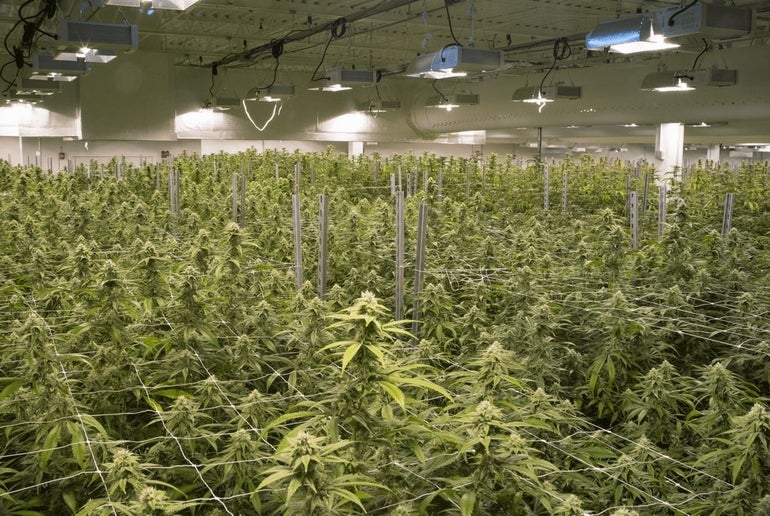Editor’s note: This story was updated with additional information from the Cannabis Control Commission, pertaining to its energy efficiency reporting requirements.
Indoor cultivation of cannabis is responsible for about 10 percent of all industrial electricity consumption in Massachusetts, a representative from the Northeast Sustainable Cannabis Project estimated Tuesday as he called on lawmakers to allow marijuana and hemp growers to use organic farming practices that could shift some of the cultivation outside and under the sun.
Indoor cannabis cultivation gives growers a more predictable (and potentially more profitable) environment but is an energy-intensive operation — powerful lights help the plants grow and HVAC systems work to maintain temperature and humidity settings around the clock. Sanford Lewis, general counsel for the Amherst-based group, said the spread of energy-hungry indoor cultivation centers runs counter to the state’s recent climate law and its greenhouse gas reduction goals.
He told the Joint Committee on Cannabis Policy that his estimate that indoor cultivation accounts for 10 percent of industrial electricity consumption is based on current indoor cultivation lighting standards and the assumption that half of the growing canopy square footage authorities have authorized is being used. Senate co-chair Sonia Chang-Diaz called the projection “remarkable.”
“Since the cannabis sector could triple in size by the time supply and demand level out, the impact is likely to be quite a bit larger,” he said. “So this means that just as other industries are working hard to curtail their climate impacts, energy-intensive indoor cannabis has come along to undermine the Massachusetts goal of reducing greenhouse gasses emitted.”
The Cannabis Control Commission has authorized more than 1.1 million square feet of indoor marijuana cultivation compared to up to 285,000 square feet of outdoor cultivation, according to its licensing data, and has imposed energy standards on indoor cultivators. In 2018, the Massachusetts Department of Energy Resources said the energy it would take to power grow lights for 660,000 square feet of cannabis canopy could negate the energy-saving effect of DOER’s $11 million program to convert more than 130,000 streetlights statewide to LEDs.
Currently, the CCC is in the initial stages of collecting energy efficiency data. The regulatory body began requiring licensing applications to satisfy reporting specifications in the Compiled Energy and Environmental Guidance, which came out of the state-mandated Energy and Environment Work Group, effective July 1, 2020.
Some may be exempt from energy efficiency and equipment standards for horticultural lighting, HVAC and dehumidification if a cultivation facility can demonstrate that at least 80% of energy generated onsite comes from an eligible onsite renewable source, as well as document it has purchased and retired renewable or alternative energy credits representing the remaining portion of energy generated offsite, if applicable, according to the CCC.
Lewis was among those who pressed the Cannabis Policy Committee on Tuesday to support a bill (H 168) filed by Peru’s Rep. Paul Mark to allow hemp and marijuana growers to use biological and botanical pesticide products that are considered appropriate for organic farming.
Jon Piasecki, who said he is the smallest recreational cannabis farmer licensed to operate outdoors in Massachusetts, said he and other outdoor growers run into a lot of problems with a powdery mildew fungus and another fungus that causes bud rot. To combat those issues, he said, CCC regulations will not allow growers to use anything other than products included on the U.S. EPA’s so-called 25(b) list.
“Some of those are marginally effective. One that I would very much like to use is on the inert list. It’s called potassium bicarbonate and it’s commonly used throughout all organic practice across the country, extensively in cannabis … Again, it’s on the 25(b) inert list and I still can’t use it,” he said. Piasecki added, “I implore you to please consider allowing us farmers to use really what every other farmer who is practicing organic agriculture in the country can use.”
Mark’s bill would direct the Department of Agricultural Resources and its Pesticide Board to authorize the use of “biological and botanical pesticide products that are considered appropriate for organic farming, provided that the EPA allows application of the product’s active and inert ingredients on food and tobacco crops and has not established a federal tolerance limit.”
Lewis said Colorado, California and Oregon already allow marijuana growers to use organic products, and Mark’s bill specifically directs MDAR to consider the regulations in those three states. The bill also has support from the Northeast Organic Farming Association.
“The current Massachusetts regulatory environment, including misguided Pesticide Board constraints addressed by this bill, is driving cannabis indoors and therefore driving up greenhouse gas emissions,” he said.
Last summer, the Cannabis Control Commission fined Garden Remedies $200,000 after investigators found that the company had been using the banned pesticide Clonex Rooting Gel since December 2017, and fined Healthy Pharms $350,000 for a subsequent pesticide use offense, the Boston Globe reported.

